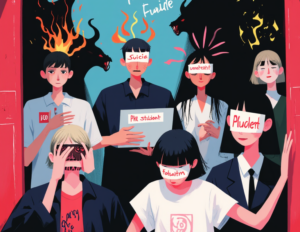
In this week’s blog post, Katherine Villavicencio (University of Chieti – Pescara) looks into the world of the mind and the mental-health issues that can result by the pressure behind a research project, such as a doctoral thesis. Here, through a personal reflexion ,she explores the main reasons that can lead candidates to suicidal thoughts, and even to the execution of them, finally advocating for targeted interventions addressing this issue in Academia.
Just like yesterday, sadness rained like a shooting star, arriving suddenly like a whisper of inspiration and dying discreetly, ephemeral, without leaving a trace when it departs. The invisible pressure, the burden of research, deeply affects doctoral students. A comprehensive review of 16 clinical studies conducted after 2015 involving 23,469 Ph.D. students found that 24% of them suffer from clinically significant symptoms of depression. The majority of these studies were carried out in the United States (approximately 69%), with additional studies being conducted in Canada, Mexico, Australia, Belgium, and South Korea (Satinsky et al., 2021). The shadow of sadness seems to constantly remain over those seeking answers that often don’t come, leaving them lost, like a shooting star that quickly fades away. Anxiety and stress seem to dominate as students feel trapped in an endless cycle of expectations, desperately searching for an escape.
Drowning the pain is like trying to cover the sun with a finger. In the academic system, especially in doctoral programs, students often constantly fight to hide their pain. The endless work, unrealistic expectations, and lack of support seem to be the blinding sun, impossible to cover. Academic pressure, tense relationships with tutors, and a competitive academic environment can deeply affect the mental health of students, like shadows that lurk at every step.
The daily struggle of grappling with the research topic.
Today, the morning has the foolishness and the gaze of the sun; ideas don’t flow, there’s no inspiration, and the mood is tired, crusty, and exhausting, with the sun spreading its rays with lethargy. This is the common feeling among those facing anxiety, which affects 17% of doctoral students in some countries like China, according to Zhang (2023). Ideas seem to escape, as if mental exhaustion prevents them from seeing beyond the endless blocks created by academic performance pressure. Students, just like the sea that feels empty and distant, struggle to find answers into a sea of exhausted thoughts. Relationships with tutors and growing competition intensify this feeling of exhaustion and lack of control.
Doctoral students can often feel that, no matter how hard they try, their efforts are in vain. They have endless tasks, research that doesn’t seem to progress, and constant pressure to innovate in a fast-pacing academic environment. Expectations become an endless ocean, where their ideas, though valuable, seem to disappear without being appreciated. The feeling of being used as cheap labour, not receiving the necessary support to advance in their research, only fuels anxiety and a sense of hopelessness. In some cases, the lack of a clear research topic in the first years of their doctoral studies amplifies this sense of emptiness, leading students to despair (Zhang, 2023).
Exclamation cry!
Give me peace, because I search and I can’t find the way back to life! This phrase resonates strongly when students cannot find an escape from the pressure they face. In China, many doctoral students find themselves trapped in a system where changing tutors is not a viable option due to power hierarchies (Zhang, 2023). The fear of retaliation and the lack of a channel to express their grievances make the situation even worse. In many cases, like that of H (Zhang, 2023), a student who took their own life because they couldn’t change tutors, desperation becomes a dead end. The lack of support and the inability to find help during moments of crisis can lead to tragedy, where suicide appears as a desperate escape.
The shadow of suicide, though it cannot be quantified with precision due to data limitations, haunts those who feel they can no longer continue. In the same analysis encompassing 16 studies and 23,469 doctoral students mentioned above, it is estimated that 17% suffer from anxiety (Satinsky et al., 2021). These percentages are alarming when compared to the general population’s rates, which range between 5 and 7%. Students may face responsibilities that go beyond the academic environment, such as financial insecurity, loneliness, and tensions in their interpersonal relationships, which increase the risk of mental disorders. In an academic environment where job opportunities are scarce and expectations are disproportionate, many may feel trapped and isolated.
The escape option.

Figure 2. “Today my tears want to commit suicide, they were born dry, they are thirsty, my crying wants to die” (La Cantata del Diablo – Mago de Oz). Recreation of the silent voices and trapped minds. Image generated by Shakker Zeno-1.
***Make them silent, there are voices here***. Voices that demand change, that seek to be heard, drown in the noise of the system. Many students can feel they have no way to complain, as they fear retaliation from their tutors and the system surrounding them. The fear of repercussions for expressing their difficulties causes many to suffer in silence. Power relations between students and tutors rarely allow the questioning of professors’ decisions, and many students are forced to accept conditions that undermine their mental health, as it was described in a previous blog here. This dynamic of power and control can leave students with few options to find an escape and live in peace.
In this context, factors such as the inability to change tutors, the impossibility of finding support, and the feeling of being just another pawn in an impersonal system contribute to a profound mental health crisis among doctoral students. This phenomenon is not unique to China; it is replicated in many other countries where students face similar academic pressures Zhang (2023). The abuse of power, the lack of channels to express complaints, and the psychological violence of many tutors leave students trapped in a desperate situation Zhang (2023). And meanwhile, the path to peace goes further away as they search, in vain, for a way out.
Desperation becomes a constant state for those who feel they have no choice but to surrender. The educational system, although designed to cultivate knowledge and innovation, is also contributing to the mental decay of those who inhabit it. “Give me peace, for that is all that those who can no longer bear the pressure truly seek”. Meanwhile, the silence of their suffering drowns in a cry that is never heard.
It is urgent to take concrete measures to prevent suicide among doctoral students, who often find themselves trapped in a spiral of stress and despair. Universities must implement accessible and effective psychological support programs, providing spaces where students can express their concerns without fear of judgment or stigma. Additionally, tutors and mentors should be trained in the early detection of mental health issues, fostering a supportive relationship rather than one of overwhelming pressure. Students must also be aware of the available resources, such as helplines and counseling services, which should be continuously promoted and made visible. The academic culture must change to recognize that emotional well-being is as important as intellectual performance, and that mental health care is essential for long-term success in any field of study.
If you are in this situation, or know someone who is, these are a few internet resources to deal with mental health issues:
National Institute of Mental Health (NIMH). NIMH is one of the leading governmental sources of information on mental health, including depression, anxiety, and suicide prevention. They offer articles, studies, and reports on a wide range of mental health conditions.
American Foundation for Suicide Prevention (AFSP). AFSP provides a wealth of educational resources, research, and tools on suicide prevention, as well as support for those struggling with suicidal thoughts.
World Health Organization (WHO) – Suicide Prevention. WHO focuses on global suicide prevention information, statistics, policies, and strategies for reducing suicide rates in various contexts.
Psychology Today. On this site, you’ll find articles on mental health, research on suicide, anxiety, depression, and other mental disorders. It also features a directory to help find therapists.
Suicide Prevention Resource Center (SPRC). SPRC offers guidelines, strategies, and resources on how to prevent suicide, working particularly with organizations to promote safety and intervention.
References:
Satinsky, E., et al., 2021. Systematic review and meta‑analysis of depression, anxiety, and suicidal ideation among Ph.D. students. Nature. Scientific reports. 11:14370. doi.org/10.1038/s41598-021-93687-7
Zhang, L., 2023. Why is suicide incidence among doctoral students so high? —A study of China’s doctoral tutorial system. Heliyon 9, e18382. doi.org/10.1016/j.heliyon.2023.e18382



Byron Iván Carriel Izquierdo
Saludos cordiales, desde Ecuador, me siento muy orgulloso que una compatriota como Katherine, esté posteando este tipo de investigación. En nuestro país la salud mental está en forma de embrión, Dios permita que en los próximos años se obtengan mejores estudios para tratar las diversas enfermedades mentales en nuestro país.